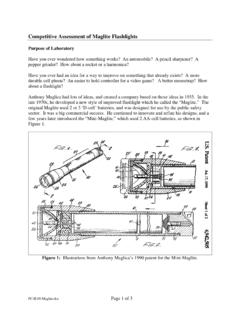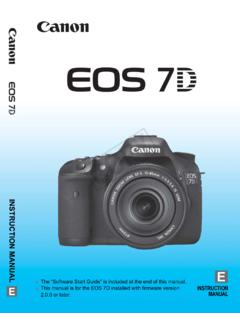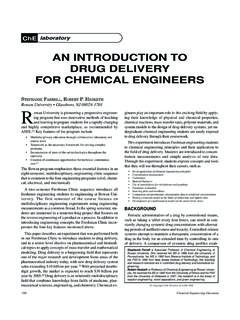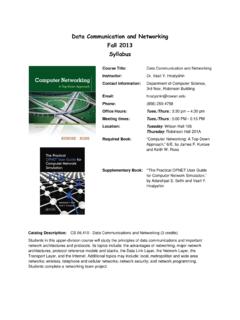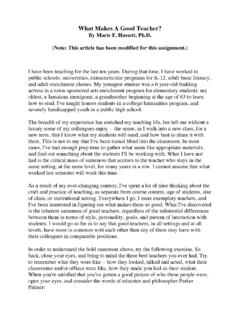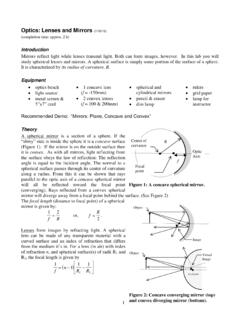Transcription of AN INTRODUCTION TO THE COMPOUND MICROSCOPE
1 AN INTRODUCTION TO THE COMPOUND MICROSCOPE . OBJECTIVE: In this lab you will learn the basic skills needed to stain and mount wet slides. You will also learn about magnification, resolution and the parts of the COMPOUND MICROSCOPE . INTRODUCTION : The light MICROSCOPE can extend our ability to see detail by 1000 times, so that we can see objects as small as micrometer (um) or 100 nanometers (nm) in diameter. The transmission electron MICROSCOPE extends this capability to objects as small as nm in diameter, 1/200,000th the size of objects that are visible to the naked eye. Without microscopes, our understanding of the structures and functions of cells and tissues would be severely limited.
2 Revealing the structure of small objects, however, is not so much a function of the MICROSCOPE 's ability to magnify as of its ability to distinguish detail. Merely magnifying an object, without increasing the amount of detail seen, is of little value to the observer. The ability to distinguish detail is called resolution or resolving power, and depends on the wavelength of light used and on a value called the numerical aperture (NA) a characteristic of microscopes that determines how much light enters the lens. In its simplest form, resolution can be expressed by the formula: wavelength resolution =.
3 2 X NA. Under normal conditions, resolution is increased by decreasing the wavelength of the light source; , if you use a green filter that permits light with a wavelength of 500 nm to pass through a MICROSCOPE lens with a NA of 1, then the resolution is 500 nm / 2 x 1, or 250 nm. This means that you can see 2 objects that are at least 250 nm apart as 2 distinct objects;. objects closer together than 250 nm will appear fuzzy or as one object. If you use a blue light (or a blue filter that provides light at a wavelength of 400 nm) and a lens having an NA of 1, the resolution would be equal to 400 nm / 2 x 1, or 200 nm.
4 The 2 objects observed under these conditions could be 50 nm closer together than those seen with a green filter and still be seen as 2 separate objects. Knowing the significance of the wavelength of light in the ability to distinguish detail, you can appreciate the role of electron microscopes and microscopes that use ultraviolet light in defining the structure and function relationships of cells and organelles (sub cellular structures). PROPER USE OF MICROSCOPES: In todays lab you will be using the COMPOUND MICROSCOPE . Despite their sturdy appearance, all microscopes are delicate, precision instruments.
5 They should be handled carefully and with common sense. The following suggestions will help you avoid some common mishaps. **To avoid breaking a cover slip and/or MICROSCOPE slide while focusing (more importantly scratching a lens), first locate the specimen using the low-power objective, and then switch to the higher power objective. **Never focus the high power objective with the coarse adjustment knob, and never use these lenses when examining thick specimens or whole mounts of specimens. **To avoid dropping the MICROSCOPE or banging it against a laboratory bench, carry the MICROSCOPE in an upright position using both hands.
6 **When carrying the MICROSCOPE , place one hand on the base and the other hand around the arm. **DO NOT PLACE THE MICROSCOPE IN AN UPSIDE DOWN POSITION. PIECES. WILL FALL OUT. **Keep MICROSCOPE away from the edge of the bench, particularly when not in use. **Make sure power cords are out of the way. **Never force the MICROSCOPE parts to work. **Never dismantle the MICROSCOPE . **Use lens cleaners and paper both before and after use. **Take all slides off the stage prior to storage. **Always store the MICROSCOPE in low power objective. **Place the cover over the MICROSCOPE after each use.
7 **Bring all defective microscopes to your instructors attention. PARTS OF A COMPOUND MICROSCOPE : Eyepiece/Ocular Lens: The eyepieces are the lenses you look through. The eyepiece of most binocular microscopes can be adjusted to match the distance between the eyes of different observers (interpupillary adjustment). Other microscopes may have different magnifications which are stamped on the side of the eyepiece. Most are 10X. You may have to remove the eyepiece from its holder to determine its magnification. Record the magnifying power of the Body Tube: Light travels from the objectives through a series of magnifying lenses in the body tube to the ocular.
8 In some microscopes, the body tube is straight; in others, the oculars are held at an angle. The body tube contains a prism that bends the light rays so that they will pass through the oculars. Objective Lens: Attached to a rotating nose piece, or turret, at the base of the body tube are a group of 3 or 4 objectives. Locate the turret and notice a click as each objective snaps into position. The objective lenses focus the light that comes through the specimen, up the body tube, and through the oculars. Each objective has numbers stamped on it. One of these numbers identifies the magnification of the objective ( , 43X).
9 Objective lenses are usually named according to their magnifying power, as follows: scanning power 4X; low power 10X; high power 43X; oil immersion 93X or 100X. A 2nd number on the objective, usually a decimal represents the numerical aperture for that lens; the abbreviation NA may precede the number. Note the magnification of each of the objectives on your MICROSCOPE below. _____ _____ _____ _____. The total magnification for each objective is calculated by multiplying the magnification of the ocular and objective lens on your MICROSCOPE . On your worksheet below calculate the total magnification for each ocular/objective combination on your MICROSCOPE .
10 List the magnification for each objective on your MICROSCOPE below. EYEPIECE/ OCULAR X OBJECTIVE = TOTAL MAGNIFICATION. Stage: The surface or platform on which you place the MICROSCOPE slide is the stage. Note the opening (stage aperture) in the center of the stage. On some microscopes, the stage is stationary and has clips to hold the slide in place. On other microscopes, the stage is movable and is called a mechanical stage. Movement is controlled by 2 knobs located on the top, side, or bottom of the stage. Note the horizontal and vertical scales on the mechanical stage. Substage: The area under the stage, called the substage, may contain a diaphragm, a condenser, or both.
